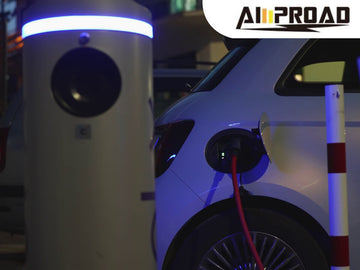
Home charging infrastructure is a key element for electric vehicle (EV) owners, offering an accessible and efficient way to keep their vehicles powered. As EVs become more popular, the demand for reliable home charging solutions has grown significantly. A dedicated home charging setup provides the convenience of recharging the EV overnight, ensuring it's ready for use each day without the need for regular trips to public charging stations. This convenience perfectly suits the evolving needs of EV drivers, making electric vehicles easier to incorporate into everyday routines.
Understanding what’s required for a home charging setup is essential for any EV owner. From selecting the right charger to navigating installation and ensuring it’s compatible with your vehicle, this process is critical in creating a customized and effective home charging experience. As the shift to sustainable transportation accelerates, answering these questions helps EV owners make informed decisions, enhancing their charging experience and contributing to the continued growth of electric vehicles.
What Types of Home Charging Stations Are Available?
Embarking on the journey of setting up home charging infrastructure involves understanding the available options, primarily Level 1, Level 2, and Level 3 DC fast charging stations. Level 1 charging is the most basic and typically involves plugging your electric vehicle (EV) into a standard household outlet. While convenient, it's essential to acknowledge its relatively slower charging speed. Level 2 charging, on the other hand, offers a faster and more efficient option, utilizing dedicated charging equipment installed at home. This type is advantageous for overnight charging, providing a significant boost to an EV's battery capacity. For those seeking even quicker charging times, Level 3 DC fast charging stations come into play. These high-speed chargers are suitable for on-the-go charging and offer the convenience of rapid energy replenishment during stops.
Understanding the benefits and considerations for each charging station type is crucial in making an informed decision. Level 1 chargers are accessible and cost-effective, making them an ideal choice for occasional use. However, for regular EV drivers, Level 2 EV charger presents a more practical solution, offering faster charging times without the complexities of Level 3 installations. Level 3 DC fast charging, while providing unmatched speed, may require more extensive setups and is often reserved for public charging stations. Evaluating your charging needs, usage patterns, and the capabilities of your electric vehicle will guide you in choosing the most suitable charging station for your home.
Guidance on selecting the right charging station involves a personalized approach based on individual needs and circumstances. Factors such as daily commute distance, EV model specifications, and anticipated charging frequency play a significant role. Seeking advice from professionals and considering future EV models' compatibility can ensure a charging station that aligns with your long-term requirements. By delving into the intricacies of each charging option and assessing your specific needs, you can confidently choose a home charging station that enhances your EV ownership experience.

What Electrical System Considerations Are Crucial for Home Charging?
Understanding the electrical system at home is a pivotal aspect when establishing a home charging infrastructure. The impact of home electrical systems on charging infrastructure is significant, as the charging station's performance relies on the capacity and capability of the electrical setup. Level 1 and Level 2 charging stations draw power from the home's electrical grid, and assessing the existing electrical system is essential to ensure it can support the charging needs without overloading circuits or causing safety hazards. This evaluation is crucial for preventing electrical issues and optimizing the efficiency of the charging station.
Assessing and potentially upgrading home electrical systems is a necessary step in preparing for home charging. Homeowners should consider factors such as the capacity of the circuit breaker, the presence of dedicated circuits for the charging station, and the overall electrical load of the home. Upgrading to a higher-capacity circuit breaker or installing dedicated circuits for the EVSE charging station may be required to accommodate the additional power demand. Seeking the expertise of a qualified electrician is recommended to conduct a thorough assessment and make necessary upgrades safely.
Ensuring compatibility and safety in setting up home charging stations involves adherence to specific guidelines and precautions. Different charging stations may have varying power requirements, and ensuring compatibility with the home's electrical system is essential to prevent issues such as overheating or circuit tripping. Safety measures, including the proper installation of the charging station, using certified equipment, and following manufacturer recommendations, contribute to a secure home charging setup. For Tesla owners, the integration of a Tesla destination charger into the home charging infrastructure can be a practical choice, providing a dedicated and optimized charging solution tailored to Tesla electric vehicles.
How Do I Choose the Right Charging Equipment for My Electric Vehicle (EV)?
Choosing the right charging equipment for your electric vehicle (EV) involves considering several crucial factors. One option to explore is the Level 2 EV charger manufactured by Amproad. When evaluating charging speed, Level 2 charging stations, including those from Amproad, offer faster charging times compared to Level 1 options. With dedicated equipment installed at home, Level 2 chargers are well-suited for regular use, providing an efficient solution for overnight charging. Understanding your EV model's charging capabilities and daily commuting needs will help determine the optimal charging speed required, and Amproad's Level 2 charger is designed to meet these demands effectively.
Compatibility with your specific EV model is paramount, and Amproad's Level 2 charger ensures seamless integration with a variety of electric vehicles. The charger is designed to accommodate different connector types and charging protocols, ensuring that it aligns with the specifications of various EV models. Additionally, considering the future-proofing aspect, Amproad's commitment to staying abreast of emerging standards and technologies enhances the longevity and relevance of your home charging infrastructure, making it adaptable to the needs of new EV models entering the market.
Making informed decisions tailored to individual EV ownership involves a personalized approach. Assessing your daily driving patterns, anticipated charging frequency, and the availability of charging infrastructure in your area are essential considerations. With the inclusion of Amproad's Level 2 EV charger in the home charging setup, owners can benefit from the manufacturer's commitment to efficient and reliable charging solutions. Seeking advice from professionals, consulting with the EV manufacturer, and staying informed about industry developments contribute to a well-informed decision-making process when selecting the right charging equipment for your electric vehicle. Whether considering Amproad's Level 2 charger or other options, this thoughtful approach ensures that your home charging setup is optimized to meet your specific EV charging needs effectively.

Is It Possible to Integrate Home Charging with Renewable Energy Sources?
Integrating home charging with renewable energy sources presents an eco-friendly option that aligns with the growing emphasis on sustainability in the electric vehicle (EV) ecosystem. One notable approach is combining home charging infrastructure with solar energy solutions. Installing solar panels on your property allows you to harness clean and renewable energy directly from the sun. This energy can be utilized to power your home charging station, reducing reliance on grid electricity and contributing to a lower carbon footprint. The exploration of this option showcases a synergy between clean energy generation and electric vehicle usage, fostering a more environmentally conscious approach to transportation.
The integration of renewable energy with home charging brings forth several benefits and considerations. One of the primary advantages is the potential reduction in electricity costs. Generating your own electricity through solar panels can lead to significant long-term savings, as you become less dependent on traditional utility providers. Additionally, the environmental benefits are substantial, as solar energy is a clean and renewable resource, producing minimal greenhouse gas emissions compared to traditional electricity sources. However, it's crucial to consider factors such as the initial investment in solar panel installation and the geographical suitability of your property for optimal solar energy production. The long-term sustainability and environmental impact make the integration of renewable energy with home charging an attractive and forward-thinking choice for EV owners.
Building a sustainable home charging system involves careful planning to optimize the use of renewable energy sources. The first step is evaluating your property for solar panel installation. Key considerations include sun exposure, available roof space, and local zoning laws, all of which affect the potential for solar energy production. Once the panels are in place, connecting them to your home EV charger allows you to power your vehicle using clean energy generated on-site. Additionally, incorporating energy storage solutions, such as home batteries, can store excess solar power produced during peak daylight hours. This stored energy can be used later, ensuring a steady power supply for your EV, even when sunlight is limited.


